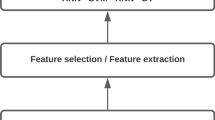Abstract
In recent years, scholars have attached increasing attention to sparse representation. Based on compressed sensing and machine learning, sparse representation-based classification (SRC) has been extensively in classification. However, SRC is not suitable for samples with non-linear structures which arise in many practical applications. Meanwhile, sparsity is overemphasized by SRC, but the correlation information which is of great importance in classification is overlooked. To address these shortcomings, this study puts forward an adaptive kernel sparse representation-based classification (AKSRC). First, the samples were mapped to a high-dimensional feature space from the original feature space. Second, after selecting a suitable kernel function, a sample is represented as the linear combination of training samples of same class. Further more, the trace norm is adopted in AKSRC which is different from general approaches. It’s adaptive to the structure of dictionary which means that a better linear representation which has the most discriminative samples can be obtained. Therefore, AKSRC has more powerful classification ability. Finally, the advancement and effectiveness of the proposed AKSRC are verified by carrying out experiments on benchmark data sets.









Similar content being viewed by others
References
Jain AK, Duin RPW, Mao J (2000) Statistical pattern recognition: a review. IEEE Trans Pattern Anal Mach Intell 22(1):4–37
Kotsiantis Sotiris B, Zaharakis I, Pintelas P (2007) Supervised machine learning: a review of classification techniques. Emerging artificial intelligence applications in computer engineering 160(3):3–24
Schölkopf B, Smola A, Müller KR (1998) Nonlinear component analysis as a kernel eigenvalue problem. Neural Comput 10(5):1299–1319
Mika S, Ratsch G, Weston J et al (1999) Fisher discriminant analysis with kernels. In: Proceedings of the IEEE signal processing society workshop, pp 41–48
Yu K, Ji L, Zhang X (2002) Kernel nearest-neighbor algorithm. Neural Process Lett 15(2):147–156
Sallee P, Olshausen BA (2003) Learning sparse multiscale image representations. Adv Neural Inf Process Syst 16:1351–1358
Rao S R, Tron R, Vidal R, et al. (2008) Motion segmentation via robust subspace separation in the presence of outlying, incomplete, or corrupted trajectories. In: IEEE conference on computer vision and pattern recognition
Yang J, Wright J, Huang T, et al. (2008) Image super-resolution as sparse representation of raw image patches. In: IEEE conference on computer vision and pattern recognition
Wright J, Yang AY, Ganesh A et al (2008) Robust face recognition via sparse representation. IEEE Trans Pattern Anal Mach Intell 31(2):210–227
Zhang Z, Xu Y, Yang J et al (2015) A survey of sparse representation: algorithms and applications. IEEE Access 3:490–530
Yin J, Liu Z, Jin Z et al (2012) Kernel sparse representation based classification. Neurocomputing 77(1):120–128
Wang J, Lu C, Wang M et al (2014) Robust face recognition via adaptive sparse representation. IEEE Trans Cybern 44(12):2368–2378
Yang Y, Ma Z, Hauptmann AG et al (2012) Feature selection for multimedia analysis by sharing information among multiple tasks. IEEE Trans Multim 15(3):661–669
Qian W, Cao F (2019) Adaptive algorithms for low-rank and sparse matrix recovery with truncated nuclear norm. Int J Mach Learn Cybern 10(6):1341–1355
Ma Z, Yang Y, Cai Y, et al. (2012) Knowledge adaptation for ad hoc multimedia event detection with few exemplars. In: Proceedings of the 20th ACM international conference on multimedia, pp 469–478
Amaldi E, Kann V (1998) On the approximability of minimizing nonzero variables or unsatisfied relations in linear systems. Theor Comput Sci 209(1):237–260
Candès EJ, Romberg JK, Tao T (2006) Stable signal recovery from incomplete and inaccurate measurements. Commun Pure Appl Math 59(8):1207–1223
Donoho DL (2006) For most large underdetermined systems of linear equations the minimal l1-norm solution is also the sparsest solution. Commun Pure Appl Math 59(6):797–829
Candès EJ, Tao T (2006) Near-optimal signal recovery from random projections: universal encoding strategies? IEEE Trans Inf Theory 52(12):5406–5425
Chen SS, Donoho DL, Saunders MA (2001) Atomic decomposition by basis pursuit. SIAM Rev 43(1):129–159
Lin Z, Liu R, Su Z (2011) Linearized alternating direction method with adaptive penalty for low rank representation. Adv Neural Inf Process Syst 24:612–620
Cai JF, Candès EJ, Shen Z (2010) A singular value thresholding algorithm for matrix completion. SIAM J Optim 20(4):1956–1982
Hale ET, Yin W, Zhang Y (2008) Fixed-point continuation for ‘1minimization: methodology and convergence. SIAM J Optim 19(3):1107–1130
Boyd S, Parikh N, Chu E et al (2011) Distributed optimization and statistical learning via the alternating direction method of multipliers. Found Trends Mach Learn 3(1):1–122
Jiang X, Lai J (2014) Sparse and dense hybrid representation via dictionary decomposition for face recognition. IEEE Trans Pattern Anal Mach Intell 37(5):1067–1079
Phillips PJ, Moon H, Rizvi SA et al (2000) The FERET evaluation methodology for face-recognition algorithms. IEEE Trans Pattern Anal Mach Intell 22(10):1090–1104
Martínez A, Benavente R (1998) The AR face database. Cvc Technical Report, 24
Muller K-R, Mika S, Ratsch G et al (2001) An introduction to kernel-based learning algorithms. IEEE Trans Neural Netw 12(2):181–201
Hollander MW, Wolf DA, Chicken E (2013) Nonparametric statistical methods. Wiley, New York, pp 84–90
Acknowledgements
The work described in this paper was supported by the National Natural Science Foundation of China (No. 61673249), the Union Fund of National Natural Science Foundation of China (No. U1805263), the Key R&D program of Shanxi Province (International Cooperation, 201903D421050), the Project Supported by the Natural Science Foundation of Shanxi Province, China (No. 201901D111030).
Author information
Authors and Affiliations
Corresponding author
Additional information
Publisher's Note
Springer Nature remains neutral with regard to jurisdictional claims in published maps and institutional affiliations.
Rights and permissions
About this article
Cite this article
Wang, X., Wang, W. & Men, C. An adaptive kernel sparse representation-based classification. Int. J. Mach. Learn. & Cyber. 11, 2209–2219 (2020). https://doi.org/10.1007/s13042-020-01110-w
Received:
Accepted:
Published:
Issue Date:
DOI: https://doi.org/10.1007/s13042-020-01110-w




